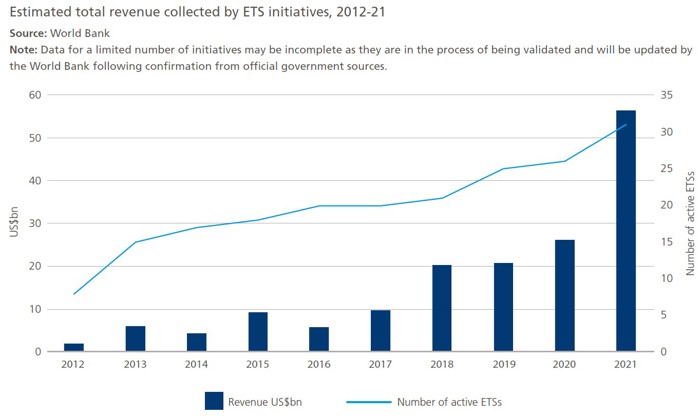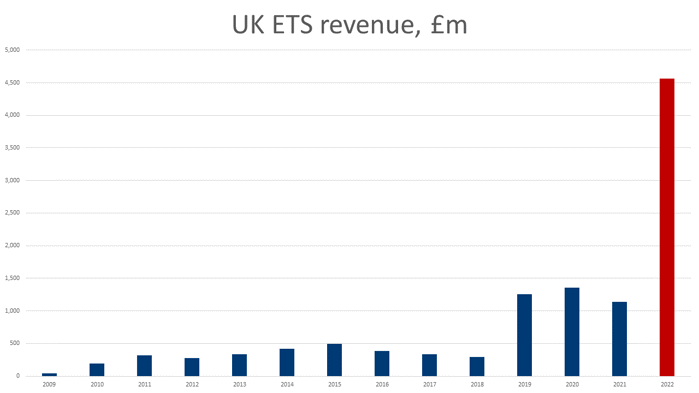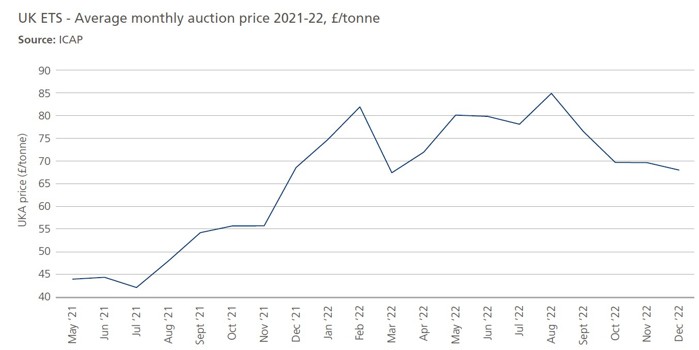Carbon-price mechanisms influence tax revenue
A few months ago, TheCityUK launched its latest Economic Research report on green and sustainable finance, in partnership with ICE: new, ground-breaking research on carbon markets.
Our report, ‘Global carbon pricing mechanisms and their interaction with carbon markets’, provides quantitative analysis of the main types of carbon-pricing instruments (carbon taxes, cap-and-trade schemes, and carbon-credit schemes). It makes explicit the link between these instruments, carbon markets, and efforts to meet net-zero carbon emissions targets.
Since we published our research, it’s been a tumultuous time in the UK for environmental policy. For example, against the backdrop of ongoing concern about the cost-of-living crisis, the government:
- postponed a forthcoming ban on the sale of new petrol and diesel cars; and
- decreased the amount of allowances available for 2024-27 under the UK Emissions Trading Scheme (ETS) by less than expected, and committed to keeping free allowances available until 2026
Green subsidies have also been in the news. The passage of the Inflation Reduction Act in the US last year, which included nearly $400bn in government subsidies for green infrastructure investment, rekindled a debate in the UK about the appropriate level of such government support. In a recent policy paper, TheCityUK noted that subsidies could be an effective tool to help scale up low-carbon investment.
Less prominent is the fact that governments around the world still spend considerable sums of money on fossil fuel subsidies, even while the debate about green subsidies picks up. Globally, fossil fuel subsidies totalled $1.3 trillion in 2022, according to data from the IMF.[1] Almost half of this spending was in South Asia, East Asia and the Pacific, although Europe and Central Asia accounted for $321bn in such subsidies. In 2021-22, explicit UK subsidies on fossil fuels totalled $27bn, all of which was for natural gas. The UK only introduced explicit fossil fuel subsidies in 2021 (although implicit subsidies have totalled around $40bn a year even prior to that).
These explicit subsidies were equivalent to around 40% of fossil fuel tax revenues. These revenues arise predominantly from the fuel duty, but also from the climate change levy, fossil fuel levy and gas levy. Fossil fuel taxes are a type of energy tax; along with transport taxes and pollution/resource taxes, energy taxes are in turn part of the universe of wider ‘environmental taxes’ in the UK. Environmental tax revenue totalled £47.4bn in 2022. In the absence of hard data about green subsidies, it’s impossible to make a parallel comparison and analyse green subsidies relative to environmental tax revenues.
Another type of energy tax is Emissions Trading Scheme (ETS) tax. Our recent research analysed ETSs as one of the main types of carbon-pricing mechanisms, noting that such ‘cap and trade’ schemes are the largest carbon pricing instrument by value in the world, and the only mechanism which controls the quantity of carbon emissions. Our analysis showed that global ETS revenue increased sharply over the decade to 2021, from $1.9bn in 2012 to $56.4bn in 2021.

Growth in the number of ETSs implemented over time; as well as an increase in ETS prices (and the increasing share of auctioned allowances rather than free allocations) both contributed to this revenue growth.
In the UK, ETS revenue rose dramatically in 2022, in tandem with the transition from the EU ETS to the new UK ETS. The UK ETS was implemented in January 2021 in the wake of Brexit, with the first payments available from 2022. ETS revenue in 2022 totalled £4.6bn, four times more than the £1.1bn garnered in 2021. Of this £4.6bn, 95% was from the UK ETS and 5% was from the EU ETS.

Source: Office for National Statistics
There are several possible explanations for this sharp increase in revenue. The fact that under the EU ETS, the UK received a proportion of a wider revenue pool is likely to have been a factor. Additionally, the EU ETS granted more free allocations than the UK ETS. The volume of auctioned allowances represented around 60% of the total allowances between 2013 and 2020, but in 2021 and 2022, auctioned allowances accounted for almost 70% of total allowances.[2] Finally, as we noted in our recent research, allowance prices rose considerably in 2022, with the monthly average increasing by 55% to £68/tonne by December 2022 from £43.99/tonne in May 2021.

The dramatic increase meant that ETS revenues accounted for 12.9% of energy tax revenues, and 9.6% of wider environmental tax revenues, in 2022, up from 3.3% and 2.6% respectively in 2021. For comparison, the fuel tax accounted for around half of all environmental tax revenue. Nevertheless, the material growth in 2022 and an ongoing focus among policymakers on net-zero carbon emissions demonstrates the potential that the UK ETS has not only in contributing to UK tax receipts overall, but in also in playing a dual role in the fight against climate change—firstly, by encouraging lower levels of emissions over time, and secondly, by generating revenue that governments can potentially use to address climate change in other ways (for example, by funding green subsidies).
[1] IMF Fossil Fuel Subsidies Data: 2023 Update.
[2]TheCityUK calculations based on data in ‘Report on the Functioning of the UK Carbon Market for2021 and 2022: a joint report from the UK ETS Authority’, available at: https://assets.publishing.service.gov.uk/government/uploads/system/uploads/attachment_data/file/1174408/functioning-of-the-uk-carbon-market.pdf


